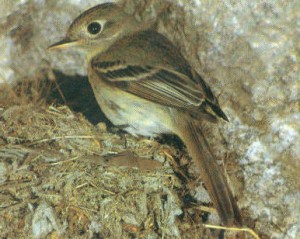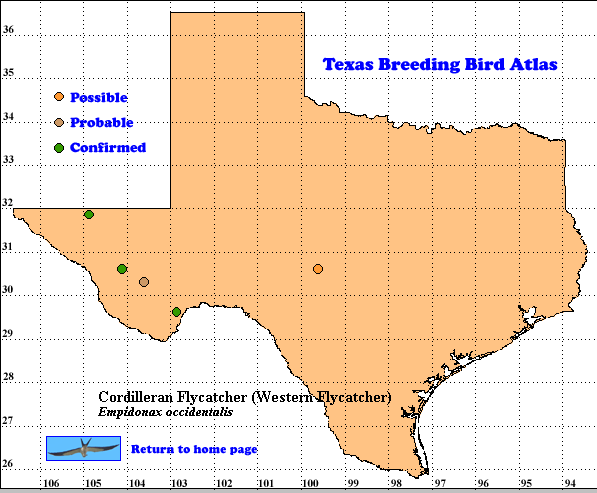Cordilleran Flycatcher, an inhabitant of the interior mountains of western North America, was formerly part of “Wester Flycatcher” with the Pacific-slope Flycatcher (Empidonax difficilis). Most of our “knowledge” of Cordilleran Flycatcher is derived from studies done on its sibling species.
The Empidonax species present in the Trans-Pecos mountains require care and experience for accurate identification; as do members of this genus at any location. Vocalizations are the most reliable means of distinguishing these visually confusing species.
DISTRIBUTION. During the 1987-1992 field work for the TBBA project atlasers found Cordilleran Flycatchers breeding in the Guadalupe, Davis and Chisos mountain ranges of Trans-Pecos Texas. Lockwood and Freeman (2004) describe there status here as locally uncommon to rare summer residents and uncommon to rare migrants throughout the region.
Outside Texas the species breeds from British Columbia and Alberta south through the interior mountains of the western United States to the higher elevations of Mexico to the Isthmus of Tehuantepec. The species winters in the southern part of the breeding range in Mexico (Howell and Web 1995, Lowther 2000).
SEASONAL OCCURRENCE. Cordilleran Flycatchers arrive in Texas from about April 8 to May 14, breed between late May and late July (egg date June 10, young just out of nest July 19) and return south approximately from August 26 to September 17 (Oberholser 1974).
BREEDING HABITAT. Cordilleran Flycatchers breed in Texas from 1800 to about 2600 m (6000 to 8500 ft) elevation among Arizona cypress, ponderosa pine, Douglas fir and big-tooth maple (Oberholser 1974).
Nests are placed in a variety of situations, generally near the ground: niches in rock-faces, among roots of upturned trees, buildings, natural cavities in live trees, on a bracket fungus, and tree stumps. The nest, often built near water, frequently contains moss, bark strips, rootlets and grasses, with a lining of fine materials, feathers and human detritus. Nest sites may be used in a succeeding year or the nest may be built in an old nest of a larger species.
The female lays 3-4, rarely 5, dull white eggs which she incubates for 14-15 days. Pairs may raise 1 or 2 broods in a season (Oberholser 1974, Harrison 1979, Lowther 2000).
STATUS. TBBA field workers found confirmed breeding evidence for Cordilleran Flycatcher in the Davis Mountains, an area where breeding or summer residency had not been reported by Oberholser (1974). The species is a locally uncommon to rare summer resident in the Trans-Pecos mountains and an uncommon to rare migrant throughout that region and the western High Plains (Lockwood and Freeman 2004).
Text by Robert C. Tweit (2005)
Literature cited.
Harrison, H. H. 1979. A field guide to western birds’ nests. Houghton Mifflin, Boston, MA.
Howell, S. N. G. and S. Webb. 1995. A guide to the birds of Mexico and northern Central America. Oxford University Press, New York.
Lockwood, M. W. and B. Freeman. 2004. The TOS handbook of Texas birds. Texas A&M University Press, College Station.
Lowther, P. E. 2000. Cordilleran Flycatcher (Empidonax occidentalis). In The birds of North America, No. 556 (A. Poole and F. Gill, eds.). The Birds of North America, Inc., Philadelphia, PA.
Oberholser, H. C. 1974. The bird life of Texas. University of Texas Press, Austin.

